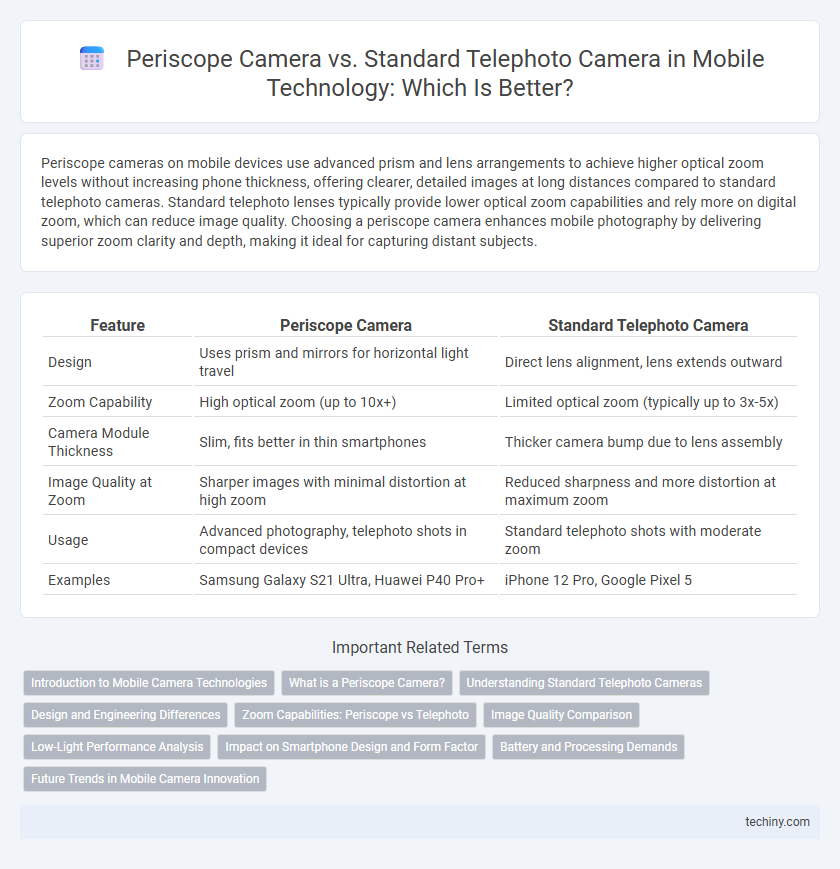Periscope cameras on mobile devices use advanced prism and lens arrangements to achieve higher optical zoom levels without increasing phone thickness, offering clearer, detailed images at long distances compared to standard telephoto cameras. Standard telephoto lenses typically provide lower optical zoom capabilities and rely more on digital zoom, which can reduce image quality. Choosing a periscope camera enhances mobile photography by delivering superior zoom clarity and depth, making it ideal for capturing distant subjects.
Table of Comparison
| Feature | Periscope Camera | Standard Telephoto Camera |
|---|---|---|
| Design | Uses prism and mirrors for horizontal light travel | Direct lens alignment, lens extends outward |
| Zoom Capability | High optical zoom (up to 10x+) | Limited optical zoom (typically up to 3x-5x) |
| Camera Module Thickness | Slim, fits better in thin smartphones | Thicker camera bump due to lens assembly |
| Image Quality at Zoom | Sharper images with minimal distortion at high zoom | Reduced sharpness and more distortion at maximum zoom |
| Usage | Advanced photography, telephoto shots in compact devices | Standard telephoto shots with moderate zoom |
| Examples | Samsung Galaxy S21 Ultra, Huawei P40 Pro+ | iPhone 12 Pro, Google Pixel 5 |
Introduction to Mobile Camera Technologies
Periscope cameras in mobile devices utilize a prism and multiple lenses arranged horizontally to achieve higher optical zoom levels, typically ranging from 5x to 10x, without increasing the phone's thickness. Standard telephoto cameras rely on a traditional lens setup aligned vertically, limiting their optical zoom capacity to around 2x to 3x due to space constraints. Advances in mobile camera technologies integrate periscope lenses to enhance zoom capabilities while maintaining compact form factors, significantly improving image clarity and detail at long distances.
What is a Periscope Camera?
A periscope camera uses a prism or mirror system to bend light at a 90-degree angle, enabling greater optical zoom capabilities within a slim smartphone body. Unlike standard telephoto cameras that rely on straightforward lens arrangements, periscope cameras achieve enhanced zoom levels, often exceeding 5x optical zoom without increasing device thickness. This technology significantly improves image detail and clarity when capturing distant subjects, revolutionizing mobile photography.
Understanding Standard Telephoto Cameras
Standard telephoto cameras feature fixed focal lengths typically ranging from 70mm to 200mm, delivering clear, detailed images by magnifying distant subjects without digital zoom degradation. These lenses use optical elements designed to reduce chromatic aberration and distortion, ensuring sharpness and color accuracy in captured photos. Compared to Periscope cameras, standard telephoto lenses offer more natural bokeh effects and faster autofocus performance in well-lit conditions.
Design and Engineering Differences
Periscope cameras feature a prism or mirror system that bends light to increase optical zoom capabilities without extending the camera module, enabling slimmer smartphone designs compared to standard telephoto lenses. Standard telephoto cameras rely on a straight lens assembly, which often results in a thicker camera bump and limits zoom functionality. Engineering periscope systems demands precise alignment and miniaturization of optical components, whereas traditional telephoto designs emphasize lens quality and sensor size within spatial constraints.
Zoom Capabilities: Periscope vs Telephoto
Periscope cameras offer significantly enhanced zoom capabilities compared to standard telephoto lenses by utilizing a folded optical path that allows for higher optical zoom levels without increasing phone thickness. Standard telephoto cameras typically max out at 2x to 3x optical zoom, while periscope cameras achieve up to 5x, 10x, or even 10x+ optical zoom ranges, providing clearer, more detailed images at a distance. This technology revolutionizes mobile photography by delivering superior long-range zoom performance with less image degradation and improved stabilization.
Image Quality Comparison
Periscope cameras use prism and mirror systems to achieve higher optical zoom levels without increasing camera module thickness, resulting in superior image clarity and detail at long distances compared to standard telephoto cameras. Standard telephoto cameras typically provide optical zoom up to 3x or 5x, whereas periscope lenses can reach 10x or more, maintaining sharpness and reducing image noise effectively. Enhanced sensor stabilization and larger apertures in periscope cameras further improve low-light performance and dynamic range, delivering higher-quality images in diverse shooting conditions.
Low-Light Performance Analysis
Periscope cameras leverage a folded optical design that allows for longer focal lengths without increasing the thickness of the device, significantly enhancing zoom capabilities in low-light conditions. Standard telephoto cameras, constrained by traditional lens arrangements, typically exhibit reduced light intake, resulting in grainier and less detailed images when lighting is poor. Advanced sensor technology and image stabilization in periscope cameras contribute to superior clarity and noise reduction during low-light photography compared to standard telephoto lenses.
Impact on Smartphone Design and Form Factor
Periscope cameras enable smartphones to achieve higher optical zoom without increasing device thickness, allowing for sleeker designs compared to standard telephoto lenses that require more space due to their longer focal length. The folded lens system in periscope cameras optimizes internal space, contributing to slimmer and lighter smartphones while maintaining advanced zoom capabilities. This innovation drives new form factors by balancing camera performance with ergonomic design, enhancing user experience without compromising device aesthetics.
Battery and Processing Demands
Periscope cameras in mobile devices require more powerful processors and increased battery consumption due to their complex lens arrangements and longer optical zoom capabilities. Standard telephoto cameras typically demand less processing power and energy, benefiting from simpler lens systems. Optimizing battery life in smartphones with periscope cameras involves advanced power management and efficient image processing algorithms.
Future Trends in Mobile Camera Innovation
Periscope cameras in mobile technology enable significantly higher optical zoom levels, surpassing the limitations of standard telephoto lenses by using a prism-based design that extends focal length without increasing device thickness. Future trends indicate the integration of AI-driven computational photography to enhance image stabilization, zoom clarity, and low-light performance in periscope cameras. Enhanced sensor technology combined with periscope architectures will drive advancements in mobile imaging capabilities, making pro-grade zoom and detail capture standard in upcoming smartphone models.
Periscope camera vs Standard telephoto camera Infographic

 techiny.com
techiny.com